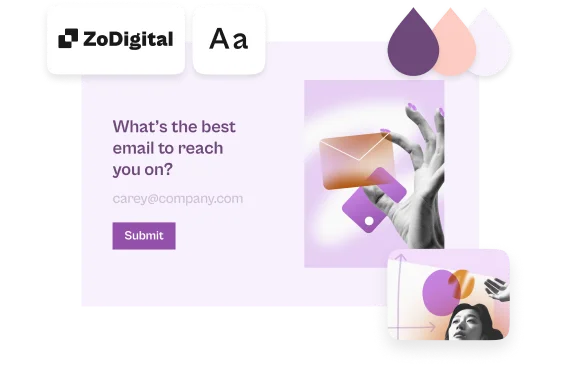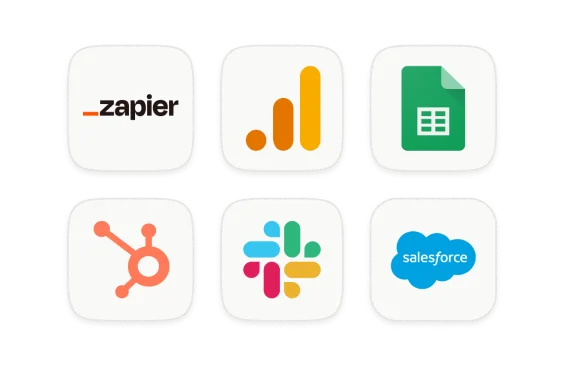10 ways to work smarter with Typeform and Airtable
Typeform’s Airtable integration allows you to send responses directly to an Airtable Base to organize and view them more effectively.
Whether you’re capturing leads, collecting survey results, running a quiz, or registering people for an event, you can now store the responses automatically in a powerful and robust way via Airtable.
How does it work?
The integration is accessed via the Connect panel in Typeform. A simple setup wizard allows you to map questions in your typeform to Airtable fields in a specific table. Once set up, answers to the questions will be automatically fired into your table ready to be filtered, grouped, sorted and processed. Find out more about setting up the integration in this Help Center article.
In order to get started you’ll need:
- A Free Typeform account
- An Airtable account
10 ideas for working smarter with Typeform and Airtable
Here are 10 ideas of timesaving things you can do with the integration. For each one we’ve included an example of the typeform used to collect the responses, along with a link to add it as a template to your Workspace. We’ll also demo how the responses for each use case look inside Airtable.
1. Manage leads and quote requests
Typeform is great for capturing leads thanks to its conversational approach to data capture. Use it to collect contact details and get more information about the services they’re looking for. Our online quote form template can help you get started.
Once you have this information, you can instantly shoot it into an Airtable Base. From here you can easily prioritize the hottest or most valuable leads using Airtable’s sorting or filtering capabilities.
In the example below, we’ve filtered all the leads who say they are ready to proceed, and sorted them by their deadline. This allows us to prioritize who to contact first without having to wade through all the data. We’ve created a Calendar view to easily see those deadlines alongside other work we might have on.
2. Handle registrations and applications
Need more players for your sports club? Want an easier way for people to sign up to your summer camp? Have to fill some slots at your avant garde poetry festival? Target your audience with a dazzling typeform and they’ll be bashing down your doors with a metaphorical digital hammer.
Here’s an example of a membership registration typeform that would get bundles of budding Buzz Aldrins signing up for your Space Club.
And what if you want to quickly see how many spare telescopes you need to order? A simple grouping applied in Airtable will clearly show you the haves and the have-nots:
3. Run quizzes and contests
A social media giveaway is a sure-fire way to keep your audience engaged. It’s easy to set up a captivating entry quiz with Typeform, whether you’re offering someone the chance to get a dollar off their next purchase or luring them with a round-the-world cruise.
For example, this Facebook-friendly contest is offering the participant a trip to Berlin…
The entries are sent straight to the Airtable Base in real time, allowing you to see everyone’s answers together. The Gallery view is particularly good for showing this because you see a separate card for each entry, making it easier to pick the best answer.
If you run regular promos like this why not use multiple tables within the same Base and shoot the responses from each typeform to a different one?
4. Do market research
Doing market research with Typeform is a no-brainer. You can extract detailed and frank information from people through a conversation-style approach designed to increase completion rates. It’s also a whole lot friendlier than cornering someone in the street and shoving a clipboard in their face.
Let’s say you wanted to run an in-depth survey to validate a potential new product line…
…you can then analyze the research in Airtable, using grouping and filtering to segment the respondents’ demographics. This will make it easier for you to spot patterns that can identify opportunities or risks.
5. Get customer feedback
The customer is always right, right? So, it’s important to listen to them. But it’s equally important to know how to listen to them or you can end up with a deafening wall of sound. Great for a track on a Phil Spector album, not great for a small business trying to improve its service.
A typeform like this one allows you to structure the feedback you receive, grouping questions together to make a coherent dialog. It mixes things up too, blending rating and opinion scales with open questions so you can make quantitative and qualitative assessments.
There’s all sorts of ways to make the most of this valuable feedback with Airtable. For example, you can group feedback from particular customer segments. This lets you pinpoint what’s working for who, and clearly see the needs for particular audience groups.
For instance, look here at how the average rating for site design changes depending on whether the customer ordered on a phone, desktop or smartwatch.
6. Plan events
Any event planner who’s seen the movie Fyre on Netflix now has regular night terrors about organizing their next bash. To avoid crashing and burning like Billy McFarland’s doomed festival, entrust Typeform and Airtable.
Here’s an example of how to get people signed up to your event without any hassle…
Thanks to the Airtable integration, you’ll immediately be able to see who’s coming, who you need to circle back with, and who to keep away from the waldorf salad.
7. Gather event feedback
Sending an event feedback typeform after the show is over is a more savvy way of capturing sentiment than asking a haggard delegate/partygoer to scribble on a questionnaire and stuff it in a box on their way out.
This typeform includes ratings-based and open-ended questions to give you an accurate picture of the highlights and lowlights so you can improve in time for the next bash.
The Sort feature within Airtable is useful here for separating your advocates from your adversaries. We can instantly see who dug the festival and maybe reach out to them for a testimonial. Likewise, we could put in a follow-up call to the one-star party poopers to find out how we can improve next year.
8. Take care of job applications
If you want to make a good impression on top talent your job application form needs to be buttery smooth. You can use a typeform as the professional, approachable face of your recruitment then have the candidates automatically sent on through to an Airtable Base. This can cut out the need for expensive talent management software and avoid stacks of resumes piling up on your desk.
For example, this typeform can be used to attract your company’s next growth hacker. It allows you to discover their related experience, grab their resume, and test them with some logic teaser questions.
Over in the Airtable, you can apply a filter to exclude certain candidates from the view. Here, we’ve filtered out those who have answered any of the test questions incorrectly. Note that Airtable has an Attachment field type, which in this case can be used to store resumes collected via the typeform.
9. Collect product feedback
“Your most unhappy customers are your greatest source of learning,” said Bill Gates. Take the opportunity to find out what’s getting people’s goat about your product and you too could be a quotable multi-billionaire.
This product feedback survey offers a way for customers and users to rate various aspects of your solution. Its conversational approach is designed with honesty in mind, so you’ll get an accurate, no-holds-barred account of what people really think.
Once the dirt has been dished by your users, you can slice and dice it as you wish in Airtable. For instance, here we’ve grouped the feedback based on the level of positivity, making it easier to explore what the fans fawned over and what the detractors detested.
10. Manage expenses
Managing expenses is a drag for everyone involved. There are some handy app solutions out there right now but if you don’t want to splash on on yet another software subscription, stick with Typeform and Airtable for the job.
Just share an expense reimbursement typeform with your staff and have them fill it in when they have incurred an expense. The form allows them to take a photo of the receipt and submit it (using the File Upload feature), along with details of the expense.
In this example, we’ve set the primary field type in the table to Autonumber. This creates a unique expense ID every time a record is created through the integration, making it easier to manage expense entries. Optionally, you can add people who need to approve expenses as Collaborators in the Airtable so they receive a notification whenever an expense is submitted.
Next steps
Itching to make something like this yourself? Thought so. Here’s how to get going:
- Sign up for Typeform and get an Airtable account.
- If you need more information on setting up and using the integration, check out our Help Center article.
- Find out how a solo-preneur uses Typeform and Airtable to avoid burnout in this case study article.


